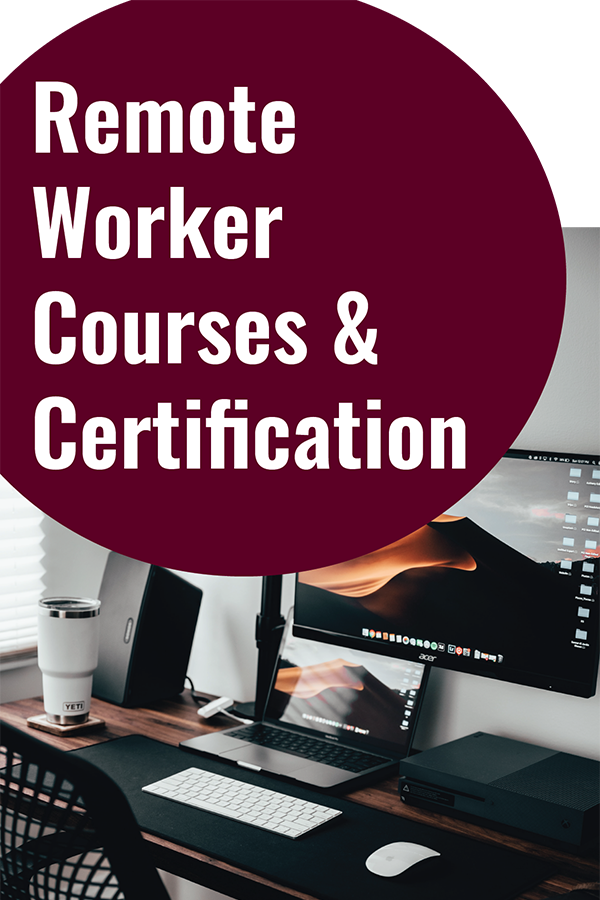What We Do
Continuing Education
 Improve your health by improving your workspace! This comprehensive program features practical and research-backed guidance to create a healthy environment at an alternative work site. Modules encompass crucial topics such as ergonomic remote work equipment; productive remote work environments; healthy work behaviors; and remote work management, policies, and programs. With each module, individuals and organizations gain valuable insights and best practices that help them create safe, efficient, and productive alternative work arrangements. The modules cover everything from indoor air quality to ergonomic equipment to effective communication practices, allowing workers to optimize their remote work and workspaces.
Improve your health by improving your workspace! This comprehensive program features practical and research-backed guidance to create a healthy environment at an alternative work site. Modules encompass crucial topics such as ergonomic remote work equipment; productive remote work environments; healthy work behaviors; and remote work management, policies, and programs. With each module, individuals and organizations gain valuable insights and best practices that help them create safe, efficient, and productive alternative work arrangements. The modules cover everything from indoor air quality to ergonomic equipment to effective communication practices, allowing workers to optimize their remote work and workspaces.
Upgrade your work environment with any one of these four courses, or buy a bundle and save!
- Certify your workspace through our innovative program! Coming soon!
Refund policy:
A full refund is available upon written request to ergocenter@tamu.edu for up to 7 calendar days after purchase unless the student completes the second lesson. A refund is forfeited when the student is able to access the third lesson. Please allow 5 business days for a refund.
 Ergonomics is crucial for long-haul drivers because of the extended time period in a seated position, which leads to discomfort, pain, and chronic musculoskeltal disorders. By adopting ergonomic principles detailed in this training, long-haul drivers can benefit in several ways:
Ergonomics is crucial for long-haul drivers because of the extended time period in a seated position, which leads to discomfort, pain, and chronic musculoskeltal disorders. By adopting ergonomic principles detailed in this training, long-haul drivers can benefit in several ways:
-
Increased Comfort: Proper ergonomics can increase driver comfort and reduce the risk of musculoskeletal disorders, such as lower back pain, neck pain, and carpal tunnel syndrome.
-
Increased Safety: Comfortable and ergonomic seating positions can improve driver alertness and concentration, which can help prevent accidents caused by driver fatigue.
-
Increased Productivity: Ergonomic adjustments can increase productivity by reducing discomfort and fatigue, leading to less downtime due to injuries or health problems.
-
Reduced Costs: Proper ergonomics can reduce healthcare costs associated with work-related musculoskeletal disorders and absenteeism.
Ergonomic awareness can help drivers recognize early warning signs of discomfort or pain and take action to address them before they become serious injuries.
This course will help you learn to adjust your truck to correctly support your body to avoid acute and chronic musculoskeletal problems. In addition, entering and exiting your truck will be covered and you’ll receive on-the-road tips so you may be healthy, well, and alert while driving.
Partnerships
From campus to career—connecting students and industry
Let us work on the projects you don't have time to complete, and together we can shape the future generation of EOH professionals. We'll assign a faculty member and students to your project and return with your desired deliverables. These project opportunities give students experience in the field while guided by professional faculty members to deliver the information you need. Projects costs are dependent on size and complexity.
Project examples:
- Field surveys
- Exposures assessment
- Training development
- Program/Process analysis
- Product mockup and testing
- Data and trend analysis
For more information or to talk through some project ideas, contact Dennis Johnson at 979.463.9505 or dpjohnson@tamu.edu.
The Industry Advisory Board's primary objective is to guide, promote, advise, and support the Environmental and Occupational Health (EOH) Department at the Texas A&M School of Public Health.
The board consists of over 100 members from various industries, state organizations, and academia who convene in person annually in the fall and virtually in the spring. They advise EOH on the competencies new graduates should possess when entering the field, advise on pertinent issues/situations, participate in benchmarking sessions and provide opportunities for the new talent graduating from Texas A&M EOH.
The two-day fall board meeting is a conference that features the latest EOH research at TAMU, student presentations, industry EOH best practices, and networking opportunities. The IAB serves as an excellent platform for regional EOH professionals to network and recruit new talent while providing advisory support to satisfy the accreditation requirements by the Council on Education for Public Health (CEPH).
EOH professionals in any industry are welcome to join. Kindly reach out to Dennis Johnson at dpjohnson@tamu.edu for more information.
TAMU EOH students are a valuable asset to companies in need of talented new professionals ready to work in the environmental and occupational health field. By offering internships to these students, companies have the opportunity to identify and recruit new talent for their organization and students receive hands-on practice for the skills they learn in their classes. Hiring a TAMU EOH student can mean bringing in fresh perspectives, innovative ideas, and a deep understanding of the latest developments and best practices in the field. By supporting these students through internships and potential employment opportunities, companies can also play a role in shaping the future of the EOH industry.
Ongoing Research
Dr. Mark Benden’s main ergonomic research is summed up in his book title, “Could You Stand to Lose.” With sedentary lifestyles contributing to a myriad of health problems, Dr. Benden’s research has focused on optimizing workspaces for position changes and regular movement for the benefit of worker health. His research has shown active workstations not only combat sedentary behavior but increase energy levels, improve cognitive function and reduce musculoskeletal issues.
Digital people could herald a new era in training, and Kaysey Aguilar, DrPH, is conducting research on ergonomic training using the new technology. A digital person is a life-like conversational avatar designed to provide training and answer questions for a one-on-one learning experience. Aguilar partnered with Nokia to provide training and discovered that remote workers responded positively to this novel approach. Her ongoing research will continue to explore the potential for digital humans to meet training needs when in-person trainers are unavailable or unsuitable for learners.
Dr. David Douphrate, a former physical therapist, transitioned his career from injury treatment to prevention, specializing in agriculture and dairy safety. The current statistics are indicative of his experience: the dairy industry alone has a fatality rate six times higher than any other industry in the agriculture, forestry, and fishing sector, and 78% of nonfatal injuries and illnesses are not included in counts maintained by federal agencies. Douphrate works with dairies and their employees across the state to study physical exposures and musculoskeletal symptoms among workers. He has found a correlation between worker health and fatigue and the health of the cattle herd. Therefore, his research at A&M will focus on investigating the cause and effects of this linkage.
Dr. Farzan Sasangohar is committed to optimizing the intersection of technology, human cognition and organizational processes to enhance patient outcomes, reduce error and cultivate a culture of safety in health care systems. His research spans ICUs to neonatal units, studying how to improve the medical workplace environment for healthcare providers to perform their best work, and as a result, see great patient outcomes.
Occupational health disparities are found in nail salons, custodial, food service, and solid waste workers just to name a few. Dr. Aurora Le conducts research on occupational safety and health interventions for these workers, with studies focused on perceived stressors, health issues and perceived interventions. By unveiling these disparities and advocating for proactive measures in these important but often overlooked occupations, Dr. Le’s work sheds light on these issues to help ensure the well-being of these often overlooked and vulnerable occupational groups.
The leading cause of work-related deaths in the U.S. is motor vehicle crashes. In 2020, 1,038 workers died in a work-related crash. Of those who died, more than half were not employed in motor vehicle operator jobs [Bureau of Labor Statistics, 2022], demonstrating the impact of these crashes on the larger population. Dr. Eva Shipp is a research scientist and instructor focused on examining crash data in farm and logging operations to develop training that can decrease the amount of worker injuries while transporting on the job. She studies injury prevention methods as well as injury data on crashes to determine ways to improve worker safety while driving.
